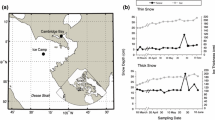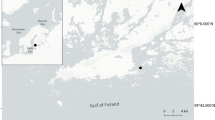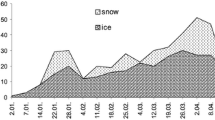Abstract
A study was undertaken to examine the activity and composition of the seasonal Baltic Sea land-fast sea-ice biota along a salinity gradient in March 2003 in a coastal location in the SW coast of Finland. Using a multi-variable data set, the less well-known algal and protozoan communities, and algal and bacterial production in relation to the physical and chemical environment were investigated. Also, the first coincident measurements of bacterial production and dissolved organic matter (DOM) in a sea-ice system are reported. Communities in sea ice were clearly autotrophy-dominated with algal biomass representing 79% of the total biomass. Protozoa and rotifers made up 18% of biomass in the ice and bacteria only 3%. Highest biomasses were found in mid-transect bottom ice. Water column assemblages were clearly more heterotrophic: 39% algae, 12% bacteria and 49% for rotifers and protozoa. Few significant correlations existed between DOM and bacterial variables, reflecting the complex origin of ice DOM. Dynamics of dissolved organic carbon, nitrogen and phosphorus (DOC, DON and DOP) were also uncoupled. A functional microbial loop is likely to be present in the studied ice. Existence of an under-ice freshwater plume affects the ecosystem functioning: Under-ice water communities are influenced directly by river-water mixing, whereas the ice system seems to be more independent—the interaction mainly taking place through the formation of active bottom communities.







Similar content being viewed by others
References
Ackley SF, Sullivan CW (1994) Physical controls on the development and characteristics of Antarctic sea ice biological communities—a review and synthesis. Deep Sea Res 41:1583–1604
Alasaarela E, Myllymaa U (1978) Investigations into the dispersal of river and waste water in the northeastern part of the Bothnian Bay in 1975–1977. Finn Mar Res 244:173–182
Bergström S, Alexandersson H, Carlsson B, Josefsson KG, Westring G (2001) Climate and hydrology of the Baltic basin. In: Wulff FV, Rahm LA, Larsson P (eds) A systems analysis of the Baltic Sea. Springer, Berlin Heidelberg New York, pp 75–112
Bjørnsen KB, Kuparinen J (1991) Determination of bacterioplankton biomass, net production and growth efficiency in the Southern Ocean. Mar Ecol Prog Ser 71:185–194
Chin-Leo G, Kirchman DL (1988) Estimating bacterial production in marine waters from the simultaneous incorporation of thymidine and leucine. Appl Environ Microbiol 54:1934–1939
Delille D, Fiala M, Kuparinen J, Kuosa H, Plessis C (2002) Seasonal changes in microbial biomass in the first-year ice of the Terre Adelié area (Antarctica). Aquat Microb Ecol 28:257–256
Edler L (ed.) (1979) Recommendations on methods for marine biological studies in the Baltic Sea. Phytoplankton and chlorophyll. The Baltic Marine Biologists, Publ. 5:1–38
Eicken H (2003) From the microscopic to the macroscopic, to the regional scale: growth, microstructure band properties on sea ice. In: Thomas DN, Dieckmann GS (eds) Sea ice: an introduction to its physics, chemistry, biology and geology. Blackwell, Oxford, pp 267–302
Fofonoff NP, Millard Jr RC (1983) Algorithms for computation of fundamental properties of seawater. UNESCO Tech Pap Mar Sci 44:58
Fuhrman JA, Azam F (1980) Bacterioplankton secondary production estimates for coastal waters of British Columbia, Antarctica and California. Appl Environ Microbiol 39:1085–1095
Fuhrman JA, Azam F (1982) Thymidine incorporation as a measure of heterotrophic bacterioplankton production in marine surface waters: evaluation and field results. Mar Biol 66:109–120
Gasol P, del Giorgio PA, Duarte CM (1997) Biomass distribution in marine planktonic communities. Limnol Oceanogr 42:1353–1363
Gosselin M, Legendre L, Therriault JL, Demers S, Rochet M (1986) Physical control of the horizontal patchiness of sea-ice microalgae. Mar Ecol Prog Ser 29:289–298
Gradinger R, Spindler M, Weissenberger J (1992) On the structure and development of Arctic pack ice communities in Fram Strait: a multivariate approach. Polar Biol 12:727–733
Granskog MA, Kaartokallio H, Shirasawa K (2003) Nutrient status of Baltic Sea ice—evidence for control of snow-ice formation, ice permeability and ice algae. J Geophys Res 108(C8):3253. DOI 10.1029/2002JC001386
Granskog MA, Ehn J, Niemelä M (2005a) Characteristics and potential impacts of under-ice river plumes in the seasonally ice-covered Bothnian Bay (Baltic Sea). J Mar Syst 53:187–196
Granskog MA, Kaartokallio H, Kuosa H, Thomas DN, Ehn J, Sonninen E (2005b) Scales of horizontal patchiness in chlorophyll a, chemical and physical properties of landfast sea ice in the Gulf of Finland (Baltic Sea). Polar Biol 28:276–283
Granskog MA, Kaartokallio H, Thomas DN, Kuosa H (2005c) Influence of freshwater inflow on the inorganic nutrient and dissolved organic matter within coastal sea ice and underlying waters in the Gulf of Finland (Baltic Sea). Est Coast Shelf Sci 65:109–122
Grasshoff K, Ehrhardt M, Kremling K (1983) Methods of seawater analysis, 2nd edn. Verlag Chemie, Weinheim, pp 419
Grimvall A, Stålnacke P (2001) Riverine inputs of nutrients to the Baltic Sea. In: Wulff FV, Rahm LA, Larsson P (eds) A systems analysis of the Baltic Sea. Springer, Berlin Heidelberg New York, pp 113–131
Grossmann S, Dieckmann GS (1994) Bacterial standing stock, activity, and carbon production during formation and growth of sea ice in the Weddell Sea, Antarctica. Appl Environ Microbiol 60:2746–2753
Guglielmo L, Carrada GC, Catalano G, Dell’Anno A, Fabiano M, Lazzara L, Mangoni O, Pusceddu A, Saggiomo V (2000) Structural and functional properties of sympagic communities in the annual sea ice at Terra Nova Bay (Ross Sea, Antarctica). Polar Biol 23:137–146
Haecky P, Jonsson S, Andersson A (1998) Influence of sea ice in the composition of the spring phytoplankton bloom in the northern Baltic Sea, Polar Biol 20:1–8
HELCOM (1988) Guidelines for the Baltic Monitoring programme third stage: part D. Biological determinands. Balt Sea Environ Proc, 27D, Helsinki Commision
Huttunen M, Niemi Å (1986) Sea-ice algae in the Northern Baltic Sea. Memo Soc Fauna Flora Fennica 62:58–62
Ikävalko J (1998) Further observations on flagellates within sea ice in northern Bothnian Bay, the Baltic Sea. Polar Biol 19:323–329
Ikävalko J, Thomsen HA (1997) The Baltic Sea ice biota (March 1994): a study of the protistan community. Europ J Protistol 33:229–243
Ingram RG (1981) Characteristics of the Great Whale River plume. J Geophys Res 86:2017–2023
Ingram RG, Larouche P (1987) Variability of an under-ice river plume in Hudson Bay. J Geophys Res 92:9541–9547
Kaartokallio H (2004) Food web components, and physical and chemical properties of Baltic Sea ice. Mar Ecol Prog Ser 237:49–63
Kattner G, Becker H (1991) Nutrients and organic nitrogenous compounds in the marginal ice zone of Fram Strait. J Mar Syst 2:385–394
Kirchman D, K’Nees E, Hodson R (1985) Leucine incorporation and its potential as a measure of protein synthesis by bacteria in natural aquatic systems. Appl Environ Microbiol 49:599–607
Kivi K, Kaitala S, Kuosa H, Kuparinen J, Leskinen E, Lignell R, Marcussen B, Tamminen T (1993) Nutrient limitation and grazing control of the Baltic plankton community during annual succession. Limnol Oceanogr 38:893–905
Krell A, Ummenhofer C, Kattner G, Naumov A, Evans D, Dieckmann GS, Thomas DN (2003) The biology and chemistry of land fast ice in the White Sea, Russia—a comparison of winter and spring conditions. Polar Biol 26:707–719
Kuosa H, Kaartokallio H (2006) Experimental evidence on nutrient and substrate limitation of Baltic Sea sea-ice algae and bacteria. Hydrobiologia 554:1–10
Legendre L, Martineau MJ, Therriault JC, Demers S (1992) Chlorophyll a biomass and growth of sea-ice microalgae along a salinity gradient (southeastern Hudson Bay, Canadian Arctic). Polar Biol 12:445–453
Legendre L, Robineau B, Gosselin M, Michel C, Ingram RG, Fortier L, Therriault JC, Demers S, Monti D (1996) Impact of freshwater on a subarctic coastal ecosystem under seasonal sea ice (southeastern Hudson Bay, Canada) II. Production and export of microalgae. J Mar Syst 7:233–250
Leppäranta M, Tikkanen M, Shemeikka P (1998) Observations of ice and its sediments on the Baltic Sea coast. Nord Hydrol 29:199–220
Massana R, Gasol JM, Bjørnsen PK, Blackburn NT, Hagström Å, Hietanen S, Hygum BH, Kuparinen J, Pedrós-Alió C (1997) Measurement of bacterial size via image analysis of epifluorescence preparations: description of an inexpensive system and solutions to some of the most common problems. Sci Mar 61:397–407
Meiners K, Fehling J, Granskog MA, Spindler M (2002) Abundance, biomass and composition of biota in Baltic sea ice and underlying water (March 2000). Polar Biol 25:761–770
Michel C, Gissel Nielsen T, Nozais C, Gosselin M (2002) Significance of sedimentation and grazing by ice micro- and meiofauna for carbon cycling in annual sea ice (northern Baffin Bay). Aquat Microb Ecol 30:57–68
Mock T, Meiners K, Giesenhagen H (1997) Bacteria in sea ice and underlying brackish water at 54°26′50 ′′ N (Baltic Sea, Kiel Bight). Mar Ecol Prog Ser 158:23–40
Mälkki P, Tamsalu R (1985) Physical features of the Baltic Sea. Finn Mar Res 252:23–27
Niemi Å (1973) Ecology of phytoplankton in the Tvärminne area, SW coast of Finland. I. Dynamics of hydrography, nutrients, chlorophyll a & phytoplankton. Acta Botanica Fennica 100:68
Niemi M, Kuparinen J, Uusi-Rauva A, Korhonen K (1983) Preparation of 14C-labeled algal samples for liquid scintillation counting. Hydrobiologia 106:149–156
Norrman B, Andersson A (1994) Development of ice biota in a temperate sea area (Gulf of Bothnia). Polar Biol 14:531–537
Olenina I, Hajdu S, Edler L, Andersson A, Wasmund N, Busch S, Göbel J, Gromisz S, Huseby S, Huttunen M, Jaanus A, Kokkonen P, Ledaine I, Niemkiewicz E (2006) Biovolumes and size-classes of phytoplankton in the Baltic Sea. HELCOM Balt Sea Environ Proc 106:144
Pelegri SP, Dolan J, Rassoulzadegan F (1999) Use of high temperature catalytic oxidation (HTCO) to measure carbon content of microorganisms. Aquat Microb Ecol 16:273–280
Poulin M, Cardinal A, Legendre L (1983) Réponse d’une communauté de diatomées de glace à un gradient de salinité (Baie d’Hudson). Mar Biol 76:191–202
Qian J, Mopper K (1996) Automated high performance, high-temperature combustion total carbon analyzer. Anal Chem 68:3090–3097
Salonen K (1981) Rapid and precise determination of total inorganic carbon and some gases in aqueous solutions. Water Res 15:403–406
Shiah FK, Ducklow HW (1997) Bacterioplankton growth responses to temperature and chlorophyll variations in estuaries measured by thymidine:leucine incorporation ratio. Aquat Microb Ecol 13:151–159
Sime-Ngando T, Demers S, Juniper KS (1999) Protozoan bacterivory in the ice and the water column of a cold temperate lagoon. Microb Ecol 37:95–106
Steemann Nielsen E (1952) The use of radioactive carbon (C14) for measuring organic production in the sea. J Cons Int Exp Mer 18:117–140
Thomas DN, Papadimitriou S (2003) Biogeochemistry of sea ice. In: Thomas DN, Dieckmann GS (eds) Sea ice: an introduction to its physics, chemistry, biology and geology. Blackwell, Oxford, pp 267–302
Thomas DN, Lara RJ, Eicken H, Kattner G, Skoog A (1995) Dissolved organic matter in Arctic multi-year sea ice during winter: major components and relationship to ice characteristics. Polar Biol 15:477–483
Utermöhl H (1958) Zur Vervollkommnung der quantitativen Phytoplankton-Methodik. Mitt Int Ver Theor Angew Limnol 9:1–38
Werner I, Auel H (2004) Environmental conditions and overwintering strategies of planktonic metazoans in and below coastal fast ice in the Gulf of Finland (Baltic Sea). Sarsia 89:102–116
Acknowledgments
Financial support for this study was provided by the Walter and Andrée de Nottbeck Foundation and Academy of Finland BIREME-programme. Tvärminne Zoological Station is acknowledged for access to its facilities and support by the station staff. A.-M. Åström (at TZS), I. Lastumäki and K. Hyvärinen (at FIMR) are acknowledged for analysing nutrients, L. Norman and D. Evans (in Bangor) for technical assistance and J. Ehn for help in the field.
Author information
Authors and Affiliations
Corresponding author
Rights and permissions
About this article
Cite this article
Kaartokallio, H., Kuosa, H., Thomas, D.N. et al. Biomass, composition and activity of organism assemblages along a salinity gradient in sea ice subjected to river discharge in the Baltic Sea. Polar Biol 30, 183–197 (2007). https://doi.org/10.1007/s00300-006-0172-z
Received:
Revised:
Accepted:
Published:
Issue Date:
DOI: https://doi.org/10.1007/s00300-006-0172-z




